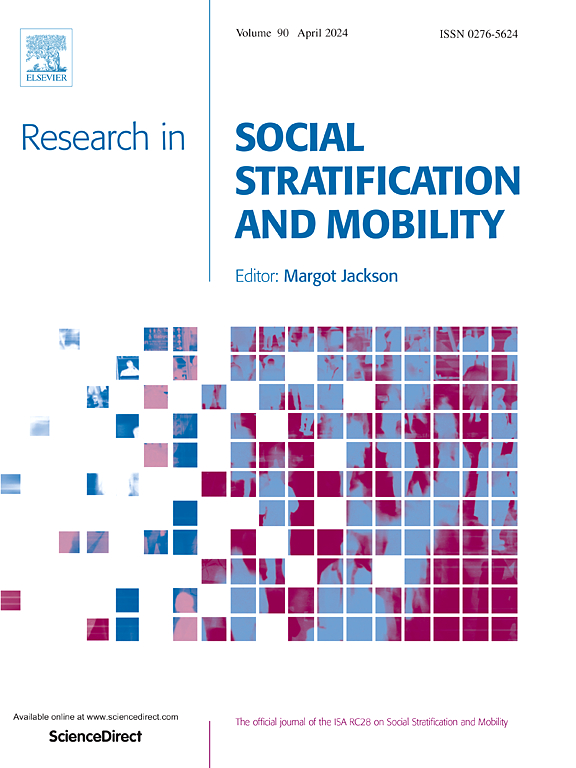The socio-organisational embeddedness of work-life mobility
IF 2.7
1区 社会学
Q1 SOCIOLOGY
引用次数: 0
Abstract
There has recently been renewed interest in occupational mobility over the life-course. We argue that such studies should place greater emphasis on organisational and social embeddings of occupations as key drivers of mobility. Occupations are interconnected by their organisational, regional, and industrial contexts, which create mobility opportunities. These contexts also foster social relations that underpin classic mobility predictors such as social capital, cultural capital, and aspiration, all of which guide occupational choices. Building on the idea that social and organisational relations between occupations shape the overall structure of social mobility, we devise a structural model that focuses not on variables, but on emergent mobility patterns. We conceptualise the mobility table as a network, fitting a loglinear model including concentration, reciprocity, and clustering parameters. This model is applied to analyse intra-generational mobility between 59 micro-classes in the UK during the first decade of this century, using data from the British Household Panel Survey. We find that emergent patterns are strong predictors of mobility. When comparing our model to a conventional social-class based one, we find that social-class parameters decrease by 88 % after the inclusion of network patterns. We conclude that the socio-organisational embeddedness of occupations is an overlooked structuring force behind work-life mobility.
工作-生活流动性的社会组织嵌入性
最近,人们对一生中职业的流动性重新产生了兴趣。我们认为,此类研究应更加强调职业的组织和社会嵌入作为流动性的关键驱动因素。职业是由他们的组织、区域和行业背景相互联系的,这创造了流动的机会。这些背景还促进了社会关系,这些社会关系支撑着社会资本、文化资本和抱负等经典的流动性预测因素,所有这些因素都指导着职业选择。基于职业之间的社会和组织关系塑造了社会流动的整体结构这一观点,我们设计了一个结构模型,该模型不关注变量,而是关注紧急流动模式。我们将流动性表概念化为一个网络,拟合一个包括浓度、互惠和聚类参数的线性模型。该模型使用英国家庭小组调查(British Household Panel Survey)的数据,分析了本世纪头十年英国59个微阶层之间的代际流动性。我们发现,涌现模式是流动性的有力预测因素。当将我们的模型与传统的基于社会阶层的模型进行比较时,我们发现在包含网络模式后,社会阶层参数减少了88 %。我们得出结论,职业的社会组织嵌入性是工作-生活流动性背后被忽视的结构性力量。
本文章由计算机程序翻译,如有差异,请以英文原文为准。
求助全文
约1分钟内获得全文
求助全文
来源期刊
CiteScore
7.80
自引率
6.00%
发文量
46
期刊介绍:
The study of social inequality is and has been one of the central preoccupations of social scientists. Research in Social Stratification and Mobility is dedicated to publishing the highest, most innovative research on issues of social inequality from a broad diversity of theoretical and methodological perspectives. The journal is also dedicated to cutting edge summaries of prior research and fruitful exchanges that will stimulate future research on issues of social inequality. The study of social inequality is and has been one of the central preoccupations of social scientists.

 求助内容:
求助内容: 应助结果提醒方式:
应助结果提醒方式:


